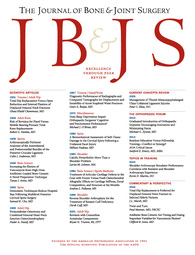
Trauma
1-3 week immobilization period following distal radius fracture improves early function vs 6 weeks
J Bone Joint Surg Am. 2018 Jul 5;100(13):1118-1125. doi: 10.2106/JBJS.17.00912133 patients with a distal radius fracture scheduled for open reduction and internal fixation with a volar plate were randomized to a postoperative immobilization period for 1 week, 3 weeks, or 6 weeks. Primary outcomes included wrist function, pain, and range of motion in wrist extension and forearm supination. Follow-up was performed at 6 weeks, 12 weeks, and 26 weeks postoperatively. Results demonstrated significantly better results related to the Patient-Rated Wrist Evaluation, visual analog scales for pain, and active range of wrist extension at 6 weeks for patients allocated to immobilization for only 1 or 3 weeks as compared to patients allocated to immobilization for 6 weeks. Differences between the three groups for results at 12 and 26 weeks were not statistically significant. Loss of fracture position over follow-up was more frequent among patients allocated with 1-week immobilization (n=4) as compared to 3-week (n=0) or 6-week (n=1) immobilization, although the difference was not statistically significant.
Unlock the full article
Get unlimited access to OrthoEvidence with a free trial
Start TrialCritical appraisals of the latest, high-impact randomized controlled trials and systematic reviews in orthopaedics
Access to OrthoEvidence podcast content, including collaborations with the Journal of Bone and Joint Surgery, interviews with internationally recognized surgeons, and roundtable discussions on orthopaedic news and topics
Subscription to The Pulse, a twice-weekly evidence-based newsletter designed to help you make better clinical decisions
Exclusive access to original content articles, including in-house systematic reviews, and articles on health research methods and hot orthopaedic topics
Or continue reading this full article
Register Now

Subscribe to "The Pulse"
Evidence-Based Orthopaedics direct to your inbox.




































